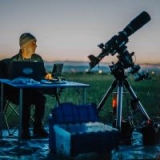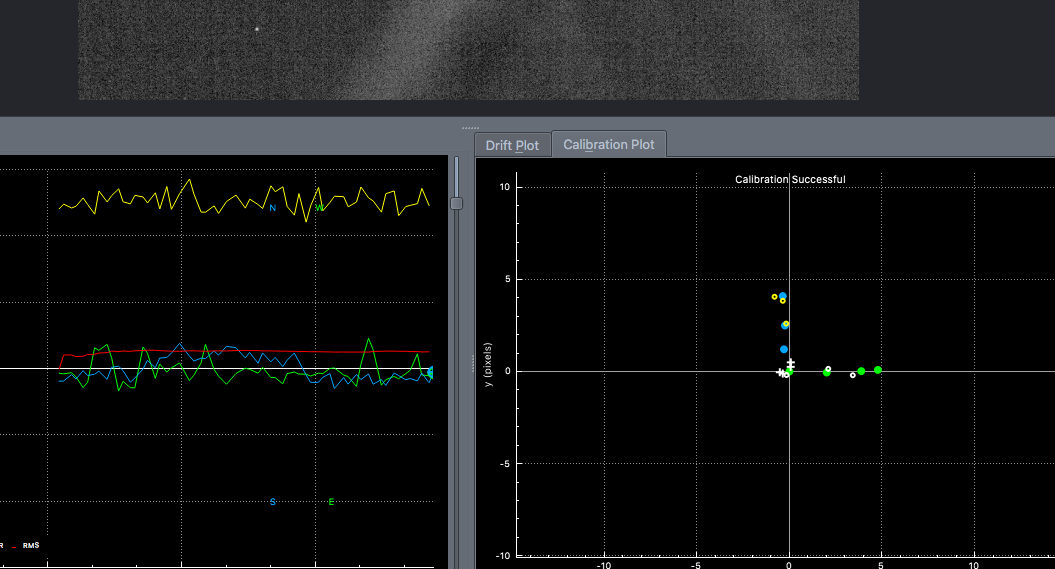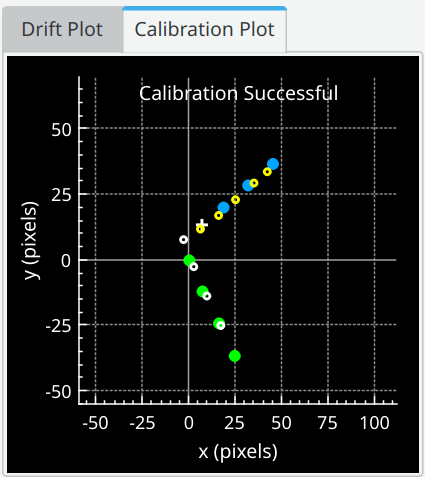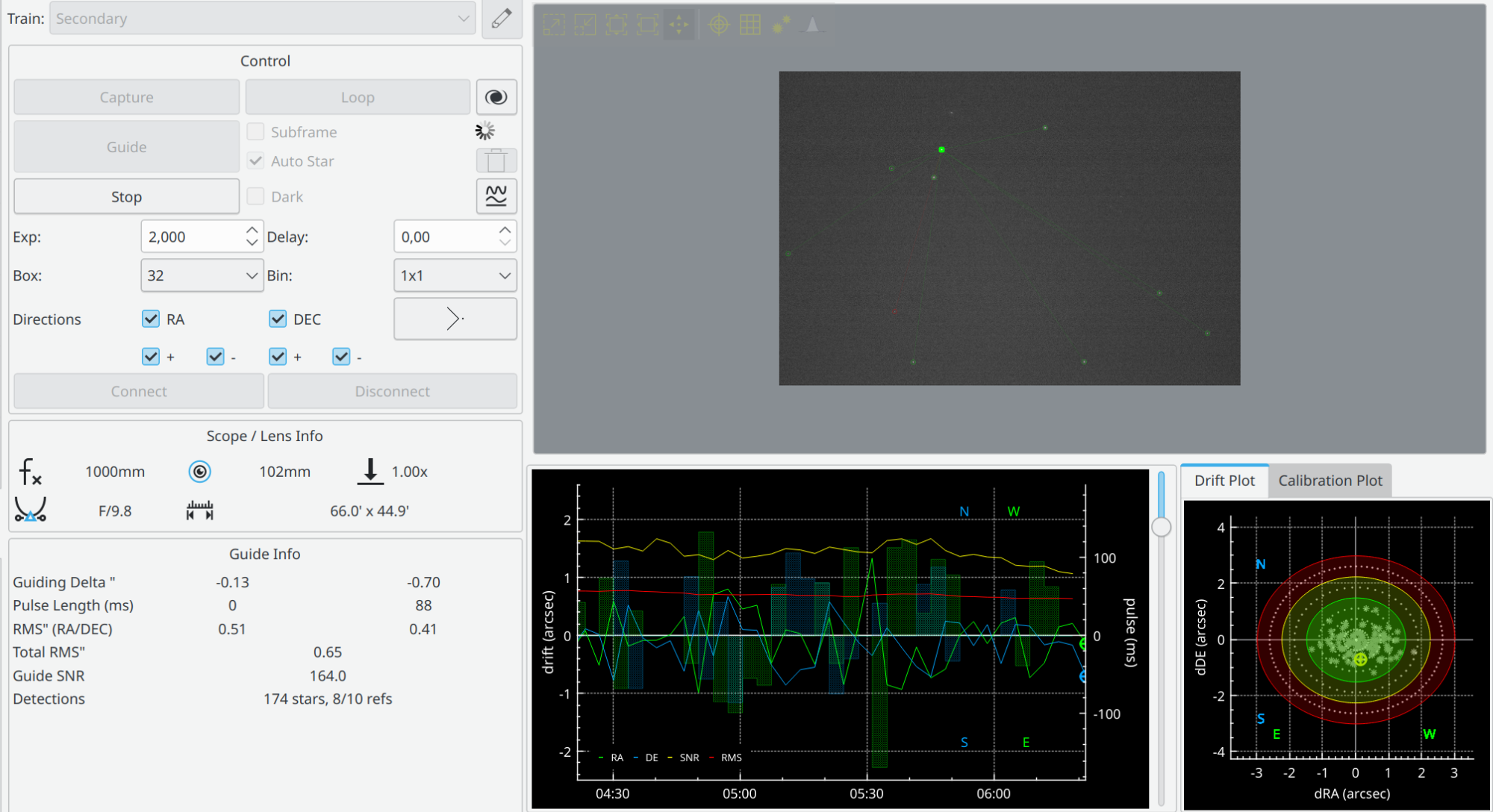INDI Library v2.0.7 is Released (01 Apr 2024)
Bi-monthly release with minor bug fixes and improvements
Poor guiding results with Losmandy mount
- Bill Tschumy
-
 Topic Author
Topic Author
- Offline
- Premium Member
-

- Posts: 104
- Thank you received: 12
Replied by Bill Tschumy on topic Poor guiding results with Losmandy mount
Can someone post a screen shot of a good calibration (preferably for Losmandy, but I'll take anything). Are the RA and Dec movements always at right angles to each other? Are the positions after successive pulses always a straight line? I'm just trying to see what I should be seeing with a good calibration.
Please Log in or Create an account to join the conversation.
Replied by Alfred on topic Poor guiding results with Losmandy mount
Attachments:
Please Log in or Create an account to join the conversation.
- Bill Tschumy
-
 Topic Author
Topic Author
- Offline
- Premium Member
-

- Posts: 104
- Thank you received: 12
Replied by Bill Tschumy on topic Poor guiding results with Losmandy mount
Thanks for the images. I guess I'm not the only one to get non-straight; non-orthogonal calibration lines. I have gotten results like this at times but it is not consistent. I will keep playing with it.
Anyone else with other mounts have examples? Are Losmandy mounts just a bit quirky?
Please Log in or Create an account to join the conversation.
- Bill Tschumy
-
 Topic Author
Topic Author
- Offline
- Premium Member
-

- Posts: 104
- Thank you received: 12
Replied by Bill Tschumy on topic Poor guiding results with Losmandy mount
I reread you excellent description of what is happening during calibration. It brought up a couple of questions:
1. It then returns to its start position without and further measurement. That is, the return flight is not used.
So a somewhat meandering return path probably doesn't matter other than an indication there might be some other problem?
2. It then does the same for DEC, except that it initially pulses until it detects movement, to remove any backlash from the measurement, and it defines its start position once it has cleared the backlash.
These are the "+"s that are displayed? Sometimes there are more than one. Why is that?
Also, I guess this is a reason for using smaller pulse sizes? If the pulse is too large it might overshoot the backlash and you would get a wrong value?
3. Here are my results:
I assume a good calibration would have the RA and Dec axes 90º apart? The fact that my Dec movement is almost 4 times that of RA seems like a problem
Bill
Attachments:
Please Log in or Create an account to join the conversation.
- Hy Murveit
-

- Away
- Administrator
-

- Posts: 1226
- Thank you received: 566
Replied by Hy Murveit on topic Poor guiding results with Losmandy mount
2- Yes, the +'s are the backlash samples
2b- "Overshooting the backlash" is not a thing. There's no problem with pulsing more than the backlash. Wherever we finish is where we mark the "start position" for computing the DEC parameters.
3- You are close enough to 90º. There is plenty of noise in these measurements, so that 91.5º you got is just fine.
3b- Yes, I am surprised that you calibrate very differently in DEC than RA, but it is possible that Losmandy designed their mounts that way. I guess I would ask other Losmandy owners. (You don't have some kind of odd camera with non-square pixels, do you? I think we assume square pixels.)
Honestly, if I were you I'd start guiding after this calibration, and if the guiding seems ok, then don't sweat the weird calibration. You can also try calibrating with PhD2 and see if it's any different. I don't know if they reveal these numbers in the UI or not, but it's definitely in their guidelogs (though it may be inverted, e.g. pixels/millisecond-of-pulse or some such).
Hy
Please Log in or Create an account to join the conversation.
- Bill Tschumy
-
 Topic Author
Topic Author
- Offline
- Premium Member
-

- Posts: 104
- Thank you received: 12
Replied by Bill Tschumy on topic Poor guiding results with Losmandy mount
However, if I changed the pulses to be 1000-1200, I got nice orthogonal axes. I suppose this might be due to a small amount of Dec backlash but If I tighten things up more, I can get "stalls" or "lags" as reported by the hand controller. Maybe I have some other issue and I will have to investigate.
However, even with the longer pulses and seemingly better calibration, my guiding wasn't as good as I'd like. It was reporting something in he ballpark of 1.4" RMS.
Frustrated, I then decided to try PHD2. I had been putting it off because it was one more thing to learn and I had to VNC into the RPi4 to control it. It didn't take too long to figure the basics out and I just tried it with all the default settings. To my surprise, the calibration when pretty well
I'm assuming PHD used its own pulse length rather than you're sending it to them. Whatever it did, it seemed to work pretty well. It did throw up a warning that the Dec movement was a bit inconsistent and there might be backlash in the Dec. I think I know that.
So I guided a bit using PHD and it worked pretty well, but not perfect. Again, as is common in the Front Range area of Colorado, the seeing wasn't great a that could be part of the issue.
What surprised me though is that the RMS reported by PHD was significantly lower than reported by Ekos.
PHD2:
Ekos:
Ekos was reporting a total RMS of 1.62" and PHD reported 1.36". This was with the same guiding data as far as I could tell. Why would that be?
I think I'm done experimenting with this mount and will hook up my newer G8/11 that has spring loaded worms that are easier to adjust. I have just finished totally cleaning and re-lubbing everything and it will be curious as to how it performs. I will experiment with Ekos guiding as well as PHD2.
Thanks for following the saga.
Bill
Attachments:
Please Log in or Create an account to join the conversation.
Replied by Len North on topic Poor guiding results with Losmandy mount
Attachments:
Please Log in or Create an account to join the conversation.
- Bill Tschumy
-
 Topic Author
Topic Author
- Offline
- Premium Member
-

- Posts: 104
- Thank you received: 12
Replied by Bill Tschumy on topic Poor guiding results with Losmandy mount
Thanks for the confirmation that something is amiss with Losmandy/Gemini guiding. If the Ekos built-in guiding used to work and now it doesn't, there must have been a change that the Gemini system doesn't like. Hy, are you the person maintaining this code? I would be happy to try to trouble shoot with whoever is in charge of it.
Yesterday I switched out my older GM8 mount to my newer G8/11. Looks like I won't have clear skies until next Monday or Tuesday. I will see if I still have the same issues with calibration not working well with Ekos but doing okay with PHD2.
Bill
Please Log in or Create an account to join the conversation.
- Hy Murveit
-

- Away
- Administrator
-

- Posts: 1226
- Thank you received: 566
Replied by Hy Murveit on topic Poor guiding results with Losmandy mount
I do maintain the guider, though I'm not as expert on things like mounts and mount drivers. Anyway, happy to help with what I can.
Hy
Please Log in or Create an account to join the conversation.
Replied by Alfred on topic Poor guiding results with Losmandy mount
Calibration
Guiding
Conditions were very bad, I had to chase stars through clouds, check out the SNR graph! Guide stars were barely visible.
This was on an old standard G-11 Gemini-1 Level 4, V1.04 (no high precision or spring loaded worms) running Indi v2.0.3-7 and KStars Build: 2023-08-21T23:32:48Z on Kubuntu 23.04.
Attachments:
Please Log in or Create an account to join the conversation.
Replied by Alfred on topic Poor guiding results with Losmandy mount
This makes sense in your case. This
is one of your calibration plots. It shows an uneven behaviour in both axes. I assume the green dots represent RA out movement. It takes RA ca. 11 pulses out and just 4 pulses in to cover the same distance. The guider derives the pulse length/arc sec value from the out movement and during guiding applies it in *both* directions which leads to massive over-correction in "RA in" direction as it would require much shorter pulses (4/11) than the guider "believes". What you'll notice is the gravity center of dots in the drift plot is shifted.
This is where integral gain comes into play. Integral gain controls how much the average of previous errors is weighted into the computation of the guide pulse. Since the everage of previous errors is on the RA in side, integral gain will add an extra compontent in RA out direction to all RA correction pulses which leads to better overall performance.
Similar issue in DEC.
Guiding should improve massively if calibration would measure pulse length/arc sec in all 4 directions instead of just 2 and apply distinct correction pulses accordingly. In theory they should be the same anyway. In practice, they are not. BTW, did you try ST-4 guiding by adding the cable and setting "Guide via:" to your guide cam in Optical Trains?
Attachments:
Please Log in or Create an account to join the conversation.
- Hy Murveit
-

- Away
- Administrator
-

- Posts: 1226
- Thank you received: 566
Replied by Hy Murveit on topic Poor guiding results with Losmandy mount
Guiding should improve massively if calibration would measure pulse length/arc sec in all 4 directions instead of just 2 and apply distinct correction pulses accordingly.
I would be very surprised if your claim is accurate. I did not create this policy, it pre-existed my involvement in KStars, but I've maintained it when I could have changed it. Note that PHD2 does the same thing (only calibrates on the outward movements). See the bullet entitled "Too Little East or South movement" here: openphdguiding.org/man/Trouble_shooting.htm
I imagine this policy is implemented to mitigate the effects of backlash on the calibration measurements.
Hy
Please Log in or Create an account to join the conversation.













